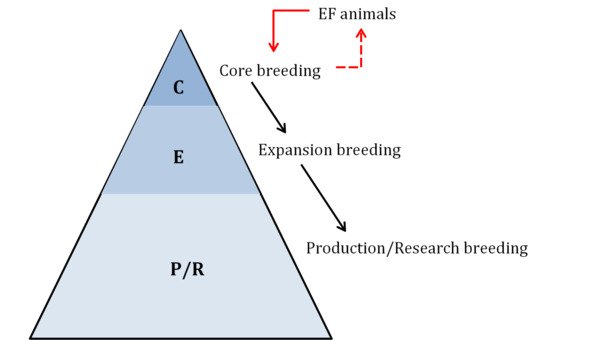Core breeding at the Wallenberg laboratory
The core breeding unit provides a unique possibility to reduce breeding of animals in the research units in order to minimise the risk of infection. The core breeding unit is intended for the maintenance of gene-modified and immunocompromised mice.
Here, breedings using a small number of cages can be maintained for long periods of time. When needed, the offspring can be transported to other KM facilities to be used in experiments, or further transported to facilities outside of KM.
The implementation of different barrier levels at KI is in place to create better conditions for animal research. That includes the possibility to move animals between different units without violating the health status of the different areas. The core breeding barrier (Barrier B2) at the KM Wallenberg Facility (KM-W) maintains the highest standard at KM for non-germ free rodents.
Maintaining the core breeding barrier
Several processes safeguard the health status of the Core breeding barrier, including:
- Only access to trained animal technicians
- Wet shower quarantine requirement for animal technicians
- Barrier infrastructure (air shower, autoclaves, gas locks)
- Handling mice with sterile forceps in laminar air flow benches
- Use of additional PPE for animal technicians
- Only accepting mice via re-derivation or from accredited vendors (see below)
Accredited vendors for the core breeding barrier
Due to the high health status of the Core breeding barrier at KM-W, the following requirements apply for purchasing animals from accredited breeders:
- Only animals from Charles River (Italy or France sites) or Janvier (France) are accepted
- Animals must have Specific Opportunist Pathogen Free (SOPF) health status
- Animals must be transported via car (transport via airplane is not permitted)
To minimise the risk of infecting the colony in the B-barrier, animals that arrive from accredited vendors are sampled and placed in a brief quarantine (estimated 2-3 weeks) before they can be introduced to the B-barrier. Please keep this in mind when planning your breeding in the B-barrier.
Purpose of core breeding
Maintaining live mice free from infections and genetically unchanged is the major purpose for keeping these animals in a protected and enclosed environment. This can be achieved by keeping a small set-up of breeding pairs for a specific strain in an area that is separate from all other barriers with limited access of personnel. In this way the core breeding unit serves as a live back-up repository for the most valuable and regularly used mice.
The core breeding is used as the basis (foundation stock colony) for each strain and is therefore a basic principle for producing animals for the expansion and production (research) colonies. It is not allowed to place mice inside the barrier without prior re-derivation. Even access of researchers is prohibited regarding the B-barrier.
Core breeding strategy
Both the core breeding and the expansion breeding are based on a strict inbreeding schedule (brother sister mating). The size of a core breeding nucleus should be around 10 to 50 breeding pairs, whereas 10 to 15 breeding pairs are normally sufficient (depending on the breeding performance of the strain). The core breeding pairs should be refreshed every 6 months, to avoid a decrease of the breeding performance.
The thorough genetic control and the refreshing of the gene pool of the strains are major prerequisites to maintain the strains in the core breeding unchanged. A genetic drift can result in the loss of the genetic modification, a changed phenotype due to mutations or loss of the initial phenotype.

a. Core breeding standard (KM-W B-barrier)
Core breeding standard normally starts with the cryopreservation (embryo- or sperm-freezing) and re-derivation of the strain to be placed into the core breeding barrier (see figure 1). This standard way of core breeding should be done:
- For valuable animals
- For animals that are frequently used in research
- For all newly produced or backcrossed animal
b. Expansion breeding (KM-W B-barrier or KM-A)
To expand the stock, breeding pairs from either the core breeding or directly after re-derivation are transferred into an expansion colony. The characteristics of this colony is:
- Strictly inbreeding
- Physical separation from the core breeding area and housing of the mice in IVC
- No or only reduced researcher access (depending on where the breeding is situated)
- A larger amount of cages
c. Production/Research breeding (KM-A or KM-B)
The next step after the expansion breeding is the production/research breeding. This colony is characterized by:
- Random breeding of the animals (no inbreeding necessary)
- Physical separation from the core and expansion breeding
- Housing of the mice in IVC
- Full researcher access
For your work in the facility
If you have a KI ID, log in at KM facilities to find hands-on resources and forms to begin your research at the Wallenberg laboratory.
